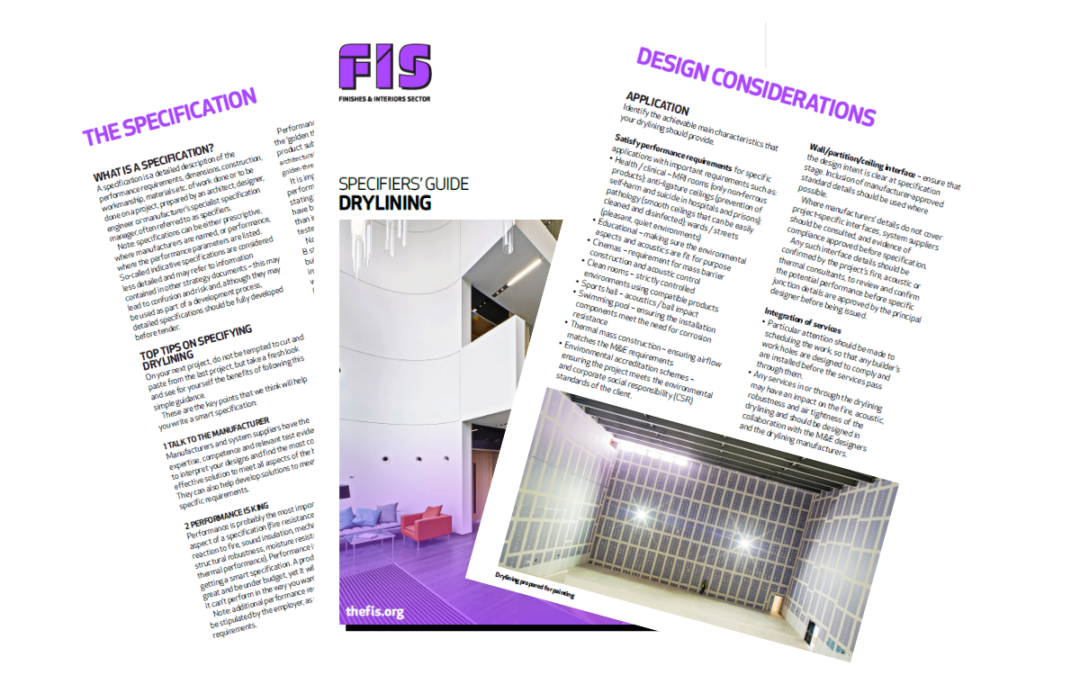
by Clair Mooney | Nov 8, 2022 | Building Safety Act, Drylining, Technical
FIS and the Tall Building Working Group (TBWG) have published a report which investigates the causes of noise emanating through the fabric of some tall buildings, identifies methods of remediation and provides guidance for affected buildings.
The Tall Building Working Group (TBWG) was formed in 2018 to address a global phenomenon where creaking can be heard in tall residential towers in high wind conditions.
The group was established under the umbrella of trade body Finishes and Interiors Sector (FIS) and set about bringing together the entire supply chain, namely developers, tier 1 contractors, manufacturers, architects, specialist drylining contractors and engineers who are involved in the specification and construction of buildings where noise issues have been reported.
The starting point was to investigate the root cause of this phenomenon and then look at how occurrence can be reduced or better managed in new towers by providing better guidance for architects, engineers, designers and developers.
The group engaged with individuals and organisations from across the globe and absorbed the findings of all available secondary research before embarking on a structured research programme of their own, funded by members of the TBWG.
Further research was carried out by structural engineers WSP to present, in a graphical format, the inter-storey differential movement in vertical and horizontal directions affecting partitions and other elements of fit out. This document explains to the project fit out designer how a high-rise tower reacts to external loads.
- External loads make building move: non-structural elements should be installed in such a way to allow for the movements freely.
- Any locked in movement will cause distress in the non-structural elements.
- Any frictional resistance to movements will cause noise.
The key to reducing the phenomenon occurring in future tall towers is sharing the information contained in the structural engineer’s movement and tolerance reports early with the system owners of the drylining, and providing movement joints to allow the elements of the internal fit out to move independently.
Manufacturers have been exploring different solutions and methods of mitigation. At this stage none have been able to completely eliminate the sound.
Commenting on the work, FIS CEO Iain McIlwee said:
“I think this is a first. I cannot think of a single time when the construction supply chain has attacked a problem in this way. Rather than battening down the risk hatches, reaching for the contract and starting the blame game, this was a genuine attempt to work together to understand and collaborate to solve it. This is a body of work all involved can be proud of, not just because it will help unravel some potentially complex issues or maybe help people sleep more soundly, but because it is an example of how we can collaborate and be better as an industry.”
The TBWG is planning to hold another conference to share the report outcomes with the delivery teams, meanwhile a summary report is available here.

by Clair Mooney | Oct 24, 2022 | Drylining, Skills
CITB-registered employers can now receive an additional £2,000 on top of the existing grant (£2,500 per year for attendance and £3,500 for achievement) for Dry Lining Apprenticeships that started from 1 April 2022 onwards. This is applicable for employers in each of the home nations.
- £1,000 paid with first quarterly attendance payment (13 weeks),
- £1,000 paid with the final quarterly attendance payment.
Your apprentice must complete 13 weeks of the apprenticeship before there is entitlement to the first £1,000 increase. A maximum drylining increase of £2,000 is payable per apprentice.
In instances where apprentices change employers:
- The first £1,000 grant is paid to the employer with which the apprentice first completes 13 weeks of their apprenticeship.
- The final £1,000 grant is paid to the employer with which the apprentice completes their attendance.
You must use an approved apprenticeship provider that is on the Register of Apprenticeship Training Providers: Download the Register of Apprenticeship Training Providers (RoATP) (education.gov.uk)
How to apply for the Grant
If CITB are your Apprenticeship provider, your dedicated Apprenticeship Officer will help you complete your application correctly. If they receive your application within 20 weeks of the start date of the apprenticeship, they will begin making your grant payments, backdated to this start date. The attendance grant will be paid automatically every 13 weeks.
If CITB are not your apprenticeship provider, you will need to complete an application form. Download and save the 2022-2023 Apprenticeship Attendance Grant application (Excel, 207KB) and ensure you complete all sections before submitting.
Please note: Use Chrome or Firefox to download the application. CITB recommend that you do not use Internet Explorer as you may have problems downloading.
You must provide evidence from your college or training provider that your apprentice is registered onto an approved apprenticeship programme. This evidence must be provided from the college or training provider on either their headed paper or from their email address and it must contain the following information:
- The full name of the apprentice.
- The full apprenticeship standard course title and level including the pathway if applicable.
- The apprentice’s start date with the college or training provider.
Evidence directly from an employer, certificates or unit credit reports are not acceptable evidence.
Send your completed application and supporting evidence as detailed above to Customer.servicesYNET@citb.co.uk.

by Oscar Venus | Sep 22, 2022 | Drylining, Main News Feed
Due to the great number of people who have boked to attend we have decided to move the venue so more of you can join us in person to The National Federation of Roofing Contractors (NFRC) venue at 31 Worship Street London EC2A 2DY Nearest tube is Old street or a short walk from Moorgate tube station.
There will be a light lunch and a chance to network from 12.30 and an opportunity to look and discuss new products from SpecWall and RawlPlug
The full agenda can be found here
- Compliance – Publication of the Building Safety Act in April
- Building Systems and Fire Walls – avoid delays at Gateway 2
- Deflection head details – how to avoid non-compliance and legacy issues when installing
- BS8000-8 standard. Guidance on design and tolerances in installation for drylining, to be published later this year
- Research project findings – the cause of creaking in tall residential towers in high wind conditions
- FIS vetting process – how it can support in managing compliance
- Competence management plans – toolkit to assist members implementing a plan
- Site Guide update – reducing waste and rework
We hope you can join us afterwards for a drink and a chance to network.
We look forward to meeting you all again, but please register early as space is limited.

by Clair Mooney | Mar 1, 2022 | Drylining, Technical
FIS has today launched its Specifiers’ Guide to Drylining to help specification writers fully understand the criteria when writing a specification for drylining, including partitions, wall linings and shaft wall systems.
The Specifiers’ Guide – Drylining was produced by the FIS Drylining Working Group which comprises representation from manufacturers, designers and contractors working in the drylining sector. Pulling together decades of experience, this guide is the third in the series of guides and is designed to help specifiers and designers understand the questions that should be addressed before the specification can be produced and then how the specification should be structured, and which standards referenced.
Commenting on the guide, Iain McIlwee, Chief Executive of FIS said:
“Specifying drylining seems, on the face of it, simple enough: consider the look, performance and cost, and there it is. If only it were that simple there would not be cases where evidence of fire compartmentation could fail or fail to perform because the issue wasn’t apparent during the specification process.”
The guide includes top tips when specifying drylining, as well as reference material to regulations for safety, fire performance and standards.
“A well written specification not only ensures the installation meets the client’s requirements, but it also means the specifier’s requirements are less open to interpretation, which is key for the whole supply chain if they are going to deliver the quality and detail first time, on time,” added Iain McIlwee.
The guide sits alongside other FIS best practice guides that relate to drylining:
Installation of Drylining
Site Guide:Drylining
These guides work well when they are included in proposals and project plans to demonstrate how to best approach a project. They are also good differentiators when someone is in competition with non-members, and are an excellent introduction to new members of the team and any trainees and apprentices.
FIS plans to have CPD material to accompany the guide later in the year.

by Clair Mooney | Jan 27, 2022 | Drylining, Skills
Leeds College of Building Interior Systems Installer Apprenticeship Programme 2022
Enrolment is now open for the Dry Lining option of the Interior Systems Installer Apprenticeship, for full details please see: Interior Systems Installer | Drylining Apprenticeship Training Course | Level 2 NVQ (lcb.ac.uk). Under the current Apprenticeship funding system, the employment of a 16-18 year old apprentice is fully funded by the government where an employer has less than 50 employees. If 50+ employees, the employer will only pay 5% of the course cost resulting in a nominal fee of £700 split across two years.
CITB registered organisations will be eligible to claim the apprentice attendance grant of £2500 per year and apprentice achievement grant at £3500. The government also offer a £1000 incentive payment to all employers who recruit a 16-18 year old apprentice.
In summary the apprenticeship training is a 24 month programme delivered on block release in 11 x 1 week blocks. This provides an opportunity for organisations anywhere in England to send their apprentices. Block release tends to make the individual capable for more tasks when they return to site. The college will assist in securing accommodation for students and for organisations that are CITB registered, grants are available for apprentice travel and subsistence covering up to 80% of the costs, please see: Apprenticeship travel and accommodation funding ‘Travel to Train’ – CITB
If you are considering taking on an apprentice and would like to find out more about the Level 2 Interior Systems Installer Apprenticeship please get in touch with the Apprenticeship Team at Leeds College of Building. They will be able to advise you on the course content, offer advice for apprenticeship levy and non-levy payers and provide details on the end point assessment (EPA). They can assist employers with the process by providing informative emails, videos and telephone assistance, Call: 0113 222 6041 or Email: wbl@lcb.ac.uk
From 1 April 2021 all employers are required to use the government apprenticeship service to secure funding for any apprentices they wish to employ. Apprentices will be unable to start their course at college without reserving funding.
FIS will be happy to provide information advice and guidance on recruiting apprentices take a look at the FIS Apprentice – Guidance for Employers, downloadable from the FIS web site at: https://www.thefis.org/skills-hub/apprenticeships-and-qualifications/apprenticeships-employers/. Alternatively call George Swann on 07553 874838 or email georgeswann@thefis.org

by Clair Mooney | Jan 21, 2022 | Drylining, Skills
CITB is looking for support to assist with its development of a traineeship for drylining occupations.
Employers and subject matter experts are invited to the meeting on Friday 28 January between 13:00 – 15:00. If you are interested in attending, contact Alexandra Lee at CITB on 07500 880181 or email alexandra.lee@citb.co.uk. To view the current version please see: Draft Dry Lining Traineeship v6.docx
What is a Traineeship
A traineeship is a skills development programme that includes a work experience placement. Traineeships help prepare young people aged 16 to 24, or 25 with an education, health and care plan, for employment or an apprenticeship. Traineeships must include at least 70 hours of work experience placement. They can last from 6 weeks up to 1 year, but most last less than 6 months. Employers can offer a work experience placement to a trainee. They will work with a training provider to design the workplace element of the programme. Traineeships are introductory courses to attract individuals, at risk of becoming long term unemployed into employment, the training should be broad and provide as much variety as possible with the work experience placement focused on a specialism.
The training provider will assess the needs of the trainee. Trainees may need pre-employment training before starting their work experience placement. Employers will then work with the training provider to plan and agree:
- the length of the work experience placement
- the days the trainee works
- how the programme will be delivered
Traineeships are flexible. Employers can change the programme as they go to make sure they and the trainee get the most out of it.
Employers must provide:
- a safe, meaningful and high-quality work experience placement
- a minimum of 70 hours of work experience placement over the duration of the traineeship (if the trainee claims benefits, the placement cannot last longer than 240 hours)
- constructive feedback and advice to the trainee
- an interview for an apprenticeship or job in their organisation at the end of the traineeship if one is available
- an exit interview at the end of the traineeship with meaningful written feedback if no job is available
Offering a work experience placement gives employers the chance to:
- get to know and work with a young person to see if they’re right for an apprenticeship or job in their business
- design a programme that suits the needs of the trainee and their business
- develop current employees’ experience in training and mentoring
- recruit new talent for their business
- claim an employer incentive of £1,000 when a work experience placement of over 70 hours has been completed
Employers who make new work experience placement opportunities available may be eligible for an incentive payment of £1,000 per trainee. They can claim this incentive for up to 10 learners per region. Employers decide how to use the money. You can view more guidance on employer incentive payments and how to claim them.
Traineeships are funded by the government. Traineeships are free to the employer, but they may choose to support trainees with expenses such as transport and meals. If you are interested in offering a work experience placement for a traineeship:
- Contact the National Apprenticeship Service to register your interest and to ask for advice and support on traineeships. They can help you set up a traineeship and advertise it on Find a traineeship.
- Partner with a training provider who will help you to design a traineeship that will meet your business needs. They will also advertise the work experience placement for you.
- Agree with the trainee and your training provider exactly what each of you expects from the traineeship.
George Swann FIS Skills and Training Lead says “Traineeships are part of the Governments Plans for Jobs; in the current system approximately 60% to 70% of people on construction training courses delivered by FE do not enter the construction industry. By providing more variety in the college element, introducing individuals to the wide range of careers available, Dry Lining Fixer Boarder and Finisher, Ceiling and Partitions Fixer, Plasterer solid and fibrous something should hook their interest and the work experience placement will put them in the work environment and show what the occupational specialism is about. It’s worth employers giving this a try as addressing the labour shortages is all about home grow talent and if you find capable individuals, well enough said. I encourage all employers and subject matter experts to get involved with the development work of CITB the more variety finishes, and interiors Traineeships have the greater the exposure of the fantastic opportunities this sector has to offer and more young people it should attract….Bigger net more fish”.





